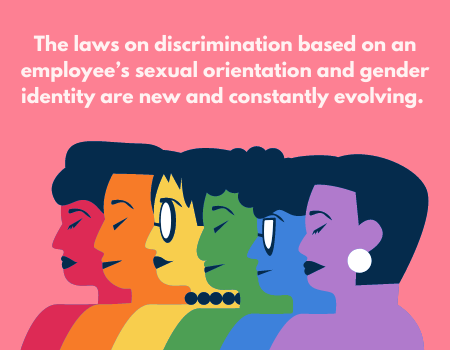Understanding sexual orientation and gender identity discrimination in the workplace
 You may consider yourself an open-minded and accepting individual, but some of your customers may have different views when it comes to LGBTQ+ issues and human rights.
You may consider yourself an open-minded and accepting individual, but some of your customers may have different views when it comes to LGBTQ+ issues and human rights.
You don’t want to make your customers uncomfortable and lose business, right? What happens if a customer complains that the sexual orientation of your employee makes them feel uncomfortable?
Take the case of a skydiving instructor. A male customer may express that they feel uncomfortable being strapped to a gay man while skydiving, but does that mean that the business is able to fire that instructor in order to prevent further complaints? The answer is no. That scenario did happen in real life. In Altitude Express, Inc. v. Zarda the Supreme Court ruled that firing the instructor constituted employment discrimination.
As a business owner, you probably already know that discrimination based on protected classes such as age, sex, and race is prohibited. But what about sexual orientation and gender identity?
The laws on discrimination based on an employee’s sexual orientation and gender identity are new and constantly evolving. Here is what you need to know to avoid engaging in unlawful employment discrimination.
Does Title VII Include Prohibit Sexual Orientation and Gender Identity Discrimination?
Title VII of the Civil Rights Act of 1964 is one of the most prominent employment laws regarding discrimination. Title VII protects workers from discrimination on the basis of sex, race, color, religion, or national origin. Title VII protects job applicants, current employees, and former employees, including federal employees and private sector employees. Title VII applies to employers that have 15 or more employees. Employers with fewer than 15 total employees and independent contractors are typically not covered by Title VII protections against discriminatory conduct.
In June 2020, the U.S. Supreme Court ruled in Bostock v. Clayton County that workplace discrimination because of an individual’s sexual orientation or gender identity—including being transgender—is unlawful discrimination under the sex portion of Title VII of the Civil Rights Act of 1964. The case involved three separate parties that had been fired from their jobs due to their sexual orientation or gender identity. The Supreme Court’s decision has been used as the basis for the current law on sexual orientation discrimination.
There have previously been attempts to pass formal acts into federal law such as the Equality Act in Congress. This bill would codify prohibitions any form of discrimination on the basis of sexual orientation, though it has yet to pass. Without formal legislation, it leaves things a little murky. However, an executive order under the Biden administration states that the federal government will read Title VII of the Civil Rights Act to include discrimination based on sexual orientation and gender identity.
What Constitutes Discrimination Under Title VII
Title VII includes a broad range of protections for employees from both federal and private employers. Under Title VII employers cannot discriminate against current, prospective, or former employees based on sexual orientation or gender identity in regards to:
-
Hiring and employment decisions.
-
Firing, layoffs, or hour reductions.
-
Promotions or demotions.
-
Disciplinary processes or actions.
-
Training and development opportunities.
-
Work assignments.
-
Compensation or benefits.
Discrimination also includes severe or pervasive harassment. Employers may not contribute to, or tolerate harassment based on, sexual orientation or gender identity. Employers may not turn a blind eye to harassment, regardless of personal beliefs. If an employee reports that they are experiencing harassment by a coworker, customer, or client due to their sexual orientation or gender identity, the employer must take steps to stop the harassment and prevent further instances of harassment.
State and Local Laws
There are also a number of state laws that prohibit discrimination on the basis of sexual orientation and gender identity. Almost half of the U.S. states, including the District of Columbia, have active laws that provide protections for employees against sexual orientation and gender identity discrimination, so be sure to know the laws in the states, cities, and counties were you do business.
How Should Employers Avoid Discrimination Against Transgender Employees
Now that we’ve established that discrimination based on gender identity is illegal, let’s look at how to be inclusive to transgender and gender-nonconforming employees in the workplace.

Preferred Names and Pronouns
Employers should respect requests from employees to use the names and pronouns that best fit each employees’ gender identity. Many employers have encouraged employees to include their preferred pronouns when introducing themselves or in their email signatures, but this is not required. Intentionally using an employee’s dead name, or the name that they used prior to transitioning or coming out, may constitute harassment or discrimination and can be harmful to transgender employees.
It is important, however, to understand the nuances in such situations. A coworker accidentally referring to a transgender male as “she” shortly after a transition, may be an honest mistake. However it is easy to see how repeatedly doing so, could be demoralizing and a form of harassment.
Dress Codes
Many employers have different dress codes for male and female employees. This is not illegal, but requiring an employee to follow the dress code set for their assigned sex at birth rather than their current gender identity can constitute sex discrimination.
Employers should honor requests from employees to adhere to the dress code of the gender that they identify as. Nonbinary employees that do not identify fully as either gender should typically be allowed to follow either dress code or wear clothing from both dress codes depending on how they feel most comfortable each day.
That being said, many dress codes, especially ones with distinct differences between genders/sexes are a bit antiquated. If your company’s dress code hasn’t been updated in a decade, it’s probably time to give it a good look and modernize it.
Equal Access to Bathrooms
Do you need to provide a separate bathroom for nonbinary and transgender people at your business? The answer is no.
While many businesses have taken to providing gender-neutral bathrooms, it is not legally required. However, if you do have a family restroom or single occupant restroom that can be helpful.
Courts have consistently recognized that employers may have separate bathrooms for men and women, or may choose to have unisex or single-use bathrooms. Both options are compliant and neither currently constitute discrimination under Title VII or other federal discrimination laws.
The U.S Equal Employment Opportunity Commission (EEOC) advises that employers may not deny an employee equal access to a bathroom, locker room, or shower that corresponds to the employee’s gender identity. This means that if an employer has separate bathrooms for men and women, all male-identifying persons (including transgender and gay men) should be allowed to use the men’s bathroom and all female-identifying persons (including transgender and lesbian women) should be allowed to use the women’s bathroom.
Should You Include Sexual Orientation in Your Harassment and Discrimination Policies?
Yes, both harassment and discrimination against employees based on their real or perceived sexual orientation or gender identity are unlawful. Employers should set clear written policies acknowledging that and making employees aware that any such harassment or discrimination will result in discipline or termination.
The use of slurs against LGBTQ+ people or other inappropriate conduct towards co-workers should not be tolerated. Inappropriate and unwelcome questions or comments about an employee’s sex partners, sexual orientation, or anatomy (such as whether a transgender employee has had gender confirmation surgery) can constitute sexual harassment or a hostile work environment.
Managers and employers have an obligation to intervene when such harassment is reported. If it is shown that appropriate actions were not taken to prevent further harassment or discrimination, the company may risk lawsuits or investigations from the EEOC or state fair employment agencies.
Stay Informed About Discrimination Laws and Employer Obligations
The laws surrounding employment discrimination are complex and frequently evolving. As you can see from the Bostock v. Clayton County case, sometimes the laws come from case rulings rather than legislation. Navigating all of your obligations as an employer can be difficult, and a mistake can prove to be costly.
To learn more about discrimination laws and how to remain compliant, check out The Employer’s Practical Legal Guide. Sexual orientation and gender identity are only two of the many protected classes covered by discrimination protections and laws.






